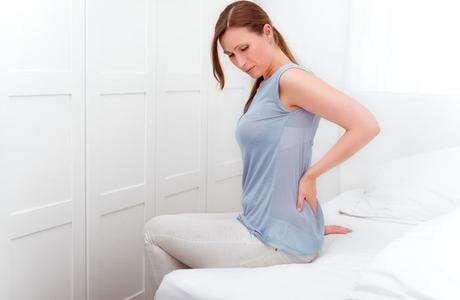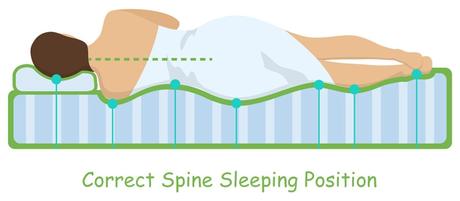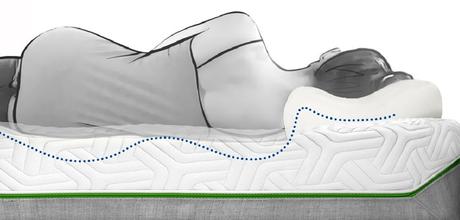The following tips to sleep better, even with lower back pain, will explain why many people suffer back pain in bed and how to reduce it or even eliminate it. It should be stated immediately that we are not physicians, and that our advice is given from the experience of people who do suffer lower back pain in bed, also known as lumbar pain.

The following are five of the most common reasons for back pain, and are presented in no particular order:
- You may sit for long periods of time, such as with many types of office work.
- You lift heavy weights as part of an exercise routine.
- Your work involves a lot of bending and stretching.
- You are of a heavier weight than you would like to be and are fairly inactive.
- Your mattress and sleeping position tends to lead to severe lower back pain.
Regarding the last two factors in that list, if you have excess body fat around your abdomen then your lower spine may be put under a level of pressure that can cause pain. You may have back pain for a number of other reasons including the above. Such pain can occur sporadically or be there all the time. Sleeping with back pain may be difficult for you, but how do you stop it from keeping you awake? Sleeping pills may help initially, but they are inadvisable and should not be a viable option for you.
It is fairly obvious to most people why they need a good level of sleep. The main reasons are to allow your muscles rest after work, to allow your brain to recover after a day of use and just as important, for your body to repair any damage done to your body cells and tissues since your last sleep. If pain disturbs your sleep, then it can lead to a number of other complaints brought on by insufficient restful sleep. Your brain needs a rest, as much as or even more than your muscles do.
The Best Sleeping Position for Lower back Pain
One solution is to find the best sleeping position for lower back pain. Most pain that you feel in bed is in your lower back. There is a good reason for that! If you look at your spine from the side, you will see that is shaped like an elongated 'S' shape.
When you lie on your back, the lower or lumbar area of your spine is the bottom curve. This can flatten out without any support. That's why memory foam mattresses are frequently recommended for those who suffer lower back pain in bed. The mattress conforms to the shape of your body, so supports your hips, shoulders and your lower back all at once.

The same is true for those who waken up with back pain but have not been aware of it while sleeping. So what steps can you take to sleep well even with severe lower back pain? Here are some suggestions for you, including the best sleeping position for lower back pain.
1. Find the Best Sleeping Position for Lower Back Pain
The best sleeping position for lower back pain may be different for different people. It is important to find yours if you have lower back pain most of the time or develop pain in lower back (lumbar region) while you sleep. In most cases, you can remain in your favorite sleeping position while also helping to reduce your level of pain. Here are simple ways of sleeping more comfortably without significantly changing your favorite position.
Side Sleepers: If you normally sleep on your side, don't sleep with your legs straight out. Place a pillow between your legs, and then draw your knees up a little towards your chest. Many find this to be a comfortable position.

Back Sleepers: If you prefer to sleep on your back, keep in mind the shape of your spine. The part of your spine between your buttocks and shoulders curves upwards when you lie in bed, and when this is compressed down it caused lumbar back pain. You need to support this part of your body. You can do this by placing a soft pillow or rolled up towel under the small of your back. This gives that part of your spine support to help prevent severe lower back pain.
A pillow under your knees will also help maintain the natural curvature of your spine. You can try each separately if you wish, and then both together. Adopt which of these options appears to help you most.

Stomach Sleepers: If you have severe back pain, and you prefer to sleep on your stomach, you should switch to your back or side if possible. Sleeping on your front places a significant strain on your spine in the lumbar region. Your vertebrae are forced out of their natural shape which in turn places extreme pressure on your discs and spinal cord.
Your discs are the discs of cartilage that lie between vertebrae to absorb shock and hold them together. They also allow easy movement when you twist and bend. If you absolutely must sleep on your front, place a pillow beneath your stomach. Doing this helps support your spine.
What if You Have Neck Pain?
The top seven vertebrae of your spine are in your neck. These are known as the cervical vertebrae from the Latin Cervix or Cervicis for ''neck". If you have neck pain, then it is important to provide support in that region to avoid further pain and damage. This can be done by choosing a pillow designed to support your head and neck and keep them in proper alignment. Check out our advice on InsideBedroom for the best pillows for neck pain.
2. Use a Good Mattress Appropriate For Your Condition
If you want to sleep better even with severe back pain, it is very important to have the right mattress. Your sleeping position and use of supportive pillows and rolled towels will certainly help, but if your mattress is not good for your body type then that pain might persist.
Consider your shoulders, waist, and hips. Each must be evenly supported whether you sleep on your back, front or side. Back pain is sure to develop or get worse if you sleep on your back and your hips are significantly wider than your waist. That's because the greater area of your hips will not sink into the mattress as much as those with smaller hips. That means that your spine in the region of your waist can tend to drop down into an unnatural position.

This is one of the benefits of a memory foam mattress. It enfolds your body and sinks where the pressure is greatest. Your hips, shoulders and the small of your back will be supported almost equally. If your mattress is too soft, your body can sink into it too much - another plus for memory foam! Innerspring mattresses with latex foam on top tend to offer more resistance.
While it was believed at one time that a hard mattress was best for those with back pain, this thinking has now been changed. In fact, it is now believed that too hard or too soft of a mattress can both promote lower back pain. Check out our review of our best mattress for back pain reviews for more details on this along with our top 8 suggestions.
How to Sleep Better Even with Severe Lower Back Pain: Summary
There are two major ways to sleep better, even with severe lower back pain. The first is to adopt the most comfortable sleeping position you can. If you sleep on your stomach, then consider changing to your side or back - these are more sensible sleeping positions for people who suffer from back pain. Take the pressure off your spine by using a pillow to help support your legs or the small of your back.
The second is to buy a mattress that provides good support for your lower back. Memory foam may work for you, but if you prefer latex foam then Talalay latex is softer than Dunlop latex, while the latter offers a firmer sleeping surface that might suit you if you sleep on your stomach.
Make use of the 'sleep test' period many mattress manufacturers offer to test the suitability of your mattress. Your choice of the pillow may also have an effect, particularly if you also suffer neck pain. That said, it is important that you find your best sleeping position for lower back pain if you want a lasting solution.

